wg48
National Hazard
   
Posts: 821
Registered: 21-11-2015
Member Is Offline
Mood: No Mood
|
|
diy gas torch
I tried to make a Bunsen burner type of gas torch out of part of a damaged disposable butane can type of gas torch that was originally used to burn
weeds.
I experimented with different diameters and length for the flame tube and added a sliding baffle to control the inlet air. It seemed impossible to get
a stable flame with an inner blue green cone which I believe is the hottest one. As the air inlet was increased the flame would lift off or blow back.
Judging from the design of some lpg burners they have a central flame surrounded several smaller flames. I assume at high gas flow rates that would
lift of the central flame the auxiliary flames keep the central flame ignited.
Below is a pic of my diy burner and a pic of the flame. It it will operate over a range of lpg flow rates with a compact flame (hence hottest) with no
adjustment of the air baffle.
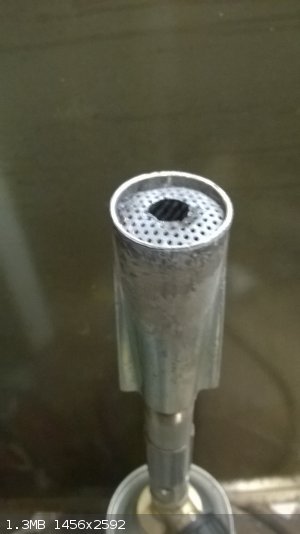
[Edited on 19-3-2016 by wg48]
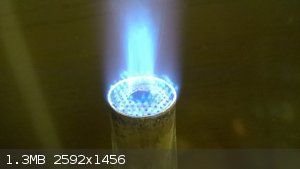
|
|
|
NedsHead
Hazard to Others
  
Posts: 409
Registered: 9-12-2014
Location: South Australia
Member Is Offline
Mood: No Mood
|
|
Have you tried putting a nozzle over the end of the burner? that and maybe larger holes in the steel mesh. this guy makes good gas torches https://www.youtube.com/watch?v=uIRTcmR6sSk skip to 3:22
|
|
|
wg48
National Hazard
   
Posts: 821
Registered: 21-11-2015
Member Is Offline
Mood: No Mood
|
|
I tried two different ceramic nozzles, shown below, but the flame lifts off and usually go out at high gas flow rates.
I don't think larger mesh holes would help. I assume if they are too large the flow velocity will be two high and the flame will lift off. My idea is
the majority of the heat output is from the central flame. I will try are larger central hole.
Interesting video. He has no central hole but when he turn up the gas the flame looked like it had an inner blue part and it did not lift off. I need
to check what gas he was using.
The disposable can I used is a pain because at high flow output the can cools and the pressure drops. Fortunately I have a refillable bottle and can
mod a helium regulator I have to fit that bottle which will provide a more constant and adjustable pressure output.
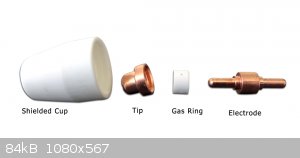
Edit:
Apparently it is difficult to stop flame lift off in burning lpg. As this cut from a patent confirms http://www.freepatentsonline.com/2005801.html
"Due to the slow burning quality of these gases, it is extremely difficult to prevent the flame from leaving the burner which causes the flame to be
extinguished and causes back-firing."
[file]49129[/file]
[Edited on 19-3-2016 by wg48]
|
|
|
NedsHead
Hazard to Others
  
Posts: 409
Registered: 9-12-2014
Location: South Australia
Member Is Offline
Mood: No Mood
|
|
Yeah, I've been trying to convert my oxy acetylene cutting torch to run LPG but I'm having the same flaming out problems as you
|
|
|
wg48
National Hazard
   
Posts: 821
Registered: 21-11-2015
Member Is Offline
Mood: No Mood
|
|
Do you run it with oxygen?
[Edited on 20-3-2016 by wg48]
|
|
|
NedsHead
Hazard to Others
  
Posts: 409
Registered: 9-12-2014
Location: South Australia
Member Is Offline
Mood: No Mood
|
|
yep, I have a large bottle of oxygen and a 9kg LPG bottle, I think my problems are with the regulators and where to set them, I'll keep adjusting to
different settings and hopefully stumble onto something that works
|
|
|
NedsHead
Hazard to Others
  
Posts: 409
Registered: 9-12-2014
Location: South Australia
Member Is Offline
Mood: No Mood
|
|
I fired up an old school burner I found today and was surprised how good it worked, running on kerosene, the thing roared like a jet
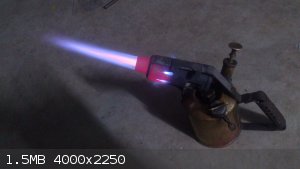
|
|
|
Daffodile
Hazard to Others
  
Posts: 167
Registered: 7-3-2016
Location: Highways of Valhalla
Member Is Offline
Mood: Riding eternal
|
|
What is that burner thing called? I haven't seen them in use before, and now I'm considering buying one from ebay or whatever. It looks like you just
fill the tank with fuel, pump it up, adjust stream, and ignite.
|
|
|
Twospoons
International Hazard
    
Posts: 1280
Registered: 26-7-2004
Location: Middle Earth
Member Is Offline
Mood: A trace of hope...
|
|
Where I come from its known as a kerosene blow lamp. They put out a truly impressive amount of heat when running properly. First thing to beak down on
them is usually the leather plunger in the pump. It can also take a little work to keep the jet clear.
Helicopter: "helico" -> spiral, "pter" -> with wings
|
|
|
NedsHead
Hazard to Others
  
Posts: 409
Registered: 9-12-2014
Location: South Australia
Member Is Offline
Mood: No Mood
|
|
yeah Twospoons, kerosene/gasoline blow lamp/blowtorch, mine is manufactured by Max Sievert but their are many others, including Primus. The leather
cup at the base of the plunger was shot so I cut a new piece from a scrap of leather.
it's almost that simple to operate Daffodile, the downside with this type of burner is you first have to pre warm it for a couple of minutes, this is
done by filling the shallow recess at the top of the tank (where the fuel line nut is) with fuel and lighting it, the kerosene will then be vaporised
before reaching the jet and being burned, once it's running it pre heats itself and only requires an occasional pump.
here it is with the highly sophisticated soldering attachment
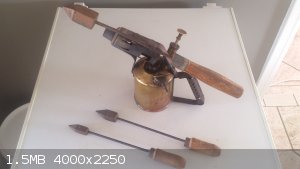
|
|
|
wg48
National Hazard
   
Posts: 821
Registered: 21-11-2015
Member Is Offline
Mood: No Mood
|
|
Update:
The problem with a simple type Bunsen burner is flash back or flame lift off occurs when you increase the air to obtain the hottest flame. You have to
operate it with a fuel rich flame for stability which is barely hot enough to melt copper and is reducing which blackens leaded glass (old florescent
tubes).
The solution is a Meker type burner which is similar to a Bunsen but has a wire mesh at the barrel exit which is also enlarged to reduce the gas
velocity. My DIY version will operate at very low gas flows without flash back and near a stoichiometric mixture which easily melts copper. I will
check if it reduces leaded glass.
|
|
|
Zyklon-A
International Hazard
    
Posts: 1547
Registered: 26-11-2013
Member Is Offline
Mood: Fluorine radical
|
|
Have you tried using a smaller diameter hole on the butane nozzle? The higher fuel pressure will do a better job pulling in the correct amount of air
and mixing it. If you look at the hole on a propane torch you'll find its so small it's hard to see. Of course propane has a much higher vapor
pressure than butane so the latter does need a bigger hole to maintain the same flow rate. But if there's not much pressure it'll burn slower which
pulls fresh air slower which makes it burn slower and this cycle will either reach a slow equilibrium or push the flame up too fast for it to stay lit
or suck the flame in (rare) and extinguish it. What it does depends on the air intake hole size and the mixing chamber size but most importantly the
fuel pressure. Get the pressure right and the air hole size is hard to mess up. That's why you don't adjust the intake hole on a propane torch.
Or so I think, but I have a habit of being right.
|
|
|
wg48
National Hazard
   
Posts: 821
Registered: 21-11-2015
Member Is Offline
Mood: No Mood
|
|
Quote: Originally posted by Zyklon-A  | Have you tried using a smaller diameter hole on the butane nozzle? The higher fuel pressure will do a better job pulling in the correct amount of air
and mixing it. If you look at the hole on a propane torch you'll find its so small it's hard to see. Of course propane has a much higher vapor
pressure than butane so the latter does need a bigger hole to maintain the same flow rate. But if there's not much pressure it'll burn slower which
pulls fresh air slower which makes it burn slower and this cycle will either reach a slow equilibrium or push the flame up too fast for it to stay lit
or suck the flame in (rare) and extinguish it. What it does depends on the air intake hole size and the mixing chamber size but most importantly the
fuel pressure. Get the pressure right and the air hole size is hard to mess up. That's why you don't adjust the intake hole on a propane torch.
Or so I think, but I have a habit of being right. |
There would be little point in trying to get more air to mix with fuel as I am confident I can already go from rich (all fuel) through stoichometric
to lean.
The flame velocity is determined by the fuel air ratio. It is maximum approximately at a stoichiometric mix which is also approximately the maximum
flame temperature.
Yes the jet holes need to be small. I have made two burners on runs one a canister of a propane butane mix with an approximately 0.1mm dia jet and a
12mm dia plain barrel no regulator. The second one runs on bottled butane with a 0 to 60psi regulator. It has an approximately 0.2 mm jet a venture
type of barrel with a max diameter of 22mm.
|
|
|
Zyklon-A
International Hazard
    
Posts: 1547
Registered: 26-11-2013
Member Is Offline
Mood: Fluorine radical
|
|
Right the goal is to get it to pull the stoichometric amount of air, whether it's on high or low. Trying to manipulate it manually is borderline a
fool's errand. Possible, but unnecessary.
The flame velocity is determined by the fuel air ratio, to a point, but a fast stream of fuel and smaller intake holes will automatically maintain the
optimal ratio. A Bunsen burner should have adjustable intake holes, but that's because it's sometimes useful to have a cooler (non-stoichometric)
flame. A well made one will not need to be adjusted to find the right ratio.
I've built several torches (no Bunsen yet) and have had the same problem. Your picture clued me in, the flame looks very slow and the perfect fuel/air
ratio won't solve the problem.
I've spent hours with that same problem and only buying a smaller nozzle fixed it.
I'm not an expert by any stretch, but I think you could solve your problem the way I solved mine. Good luck.
|
|
|
The Volatile Chemist
International Hazard
    
Posts: 1981
Registered: 22-3-2014
Location: 'Stil' in the lab...
Member Is Offline
Mood: Copious
|
|
Anyone know of a DIY burner design similar to the one Doug's Lab uses? It appears to be constructed of steel piping...
|
|
|
wg48
National Hazard
   
Posts: 821
Registered: 21-11-2015
Member Is Offline
Mood: No Mood
|
|
I am not familiar with Doug's design if you can provide some details of your requirements such as gas to be used its pressure size of burner I may be
able to offer some help.
|
|
|
The Volatile Chemist
International Hazard
    
Posts: 1981
Registered: 22-3-2014
Location: 'Stil' in the lab...
Member Is Offline
Mood: Copious
|
|
Quote: Originally posted by wg48  |
I am not familiar with Doug's design if you can provide some details of your requirements such as gas to be used its pressure size of burner I may be
able to offer some help. |
Well, I'm thinking something able to be made of hardware from a hardware shop, or modified hardware - preferably steel/copper piping or other such
hardware. Running it off of methane would be nice, but since it's hard to get, butane or propane (or petrol - gasoline? I don't suppose a typical
burner could get very hot with non-pressurized gasoline) would be best. And simply the pressure from the source of gas, be it the propane tank, etc.
And, specifically, Bunsen burner flame proportions (long flame, small base) but not the small size most burners come in.
|
|
|
wg48
National Hazard
   
Posts: 821
Registered: 21-11-2015
Member Is Offline
Mood: No Mood
|
|
Quote: Originally posted by The Volatile Chemist  | Quote: Originally posted by wg48  |
I am not familiar with Doug's design if you can provide some details of your requirements such as gas to be used its pressure size of burner I may be
able to offer some help. |
Well, I'm thinking something able to be made of hardware from a hardware shop, or modified hardware - preferably steel/copper piping or
other such hardware. Running it off of methane would be nice, but since it's hard to get, butane or propane (or petrol - gasoline? I don't suppose a
typical burner could get very hot with non-pressurized gasoline) would be best. And simply the pressure from the source of gas, be it the propane
tank, etc. And, specifically, Bunsen burner flame proportions (long flame, small base) but not the small size most burners come in.
|
My burners were made from salvaged parts. The one relevant here was constructed from the venture tube and jet extracted from a discarded radiant room
heater that used butane bottle with a 37mbar regulator. It was almost ready to use as a simple bunsen burner except that the air fuel ratio needed to
be adjusted to compensate for the reduced back pressure caused by the missing ceramic radiator part.
If you google "design of a lpg burner" you will find several constructed from hardware shop parts that run on bottled butane with a regulator.
Note that simple bunsen type burners have to operate with reducing flames for stability and therefore their temperature is less and can be less than
1000C.
|
|
|
The Volatile Chemist
International Hazard
    
Posts: 1981
Registered: 22-3-2014
Location: 'Stil' in the lab...
Member Is Offline
Mood: Copious
|
|
Thanks, I'll look into it.
|
|
|
Morgan
International Hazard
    
Posts: 1660
Registered: 28-12-2010
Member Is Offline
Mood: No Mood
|
|
This had some good historical information on the evolution of gas lighting, its drawbacks, and methods of improvement.There was some mention of a
Bunsen burner and it was just sort of interesting from a combustion chemistry point of view.
How the gas mantle made lamps 10X brighter
https://youtu.be/F3rncxf4Or8
[Edited on 20-5-2022 by Morgan]
|
|
|
Texium
|
Thread Moved
30-11-2023 at 10:25 |